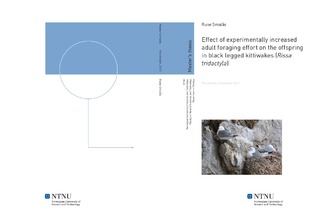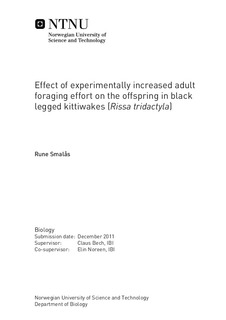| dc.description.abstract | The Black legged Kittiwake (Rissa tridactyla) is one of the more extensively studied seagull species, and much of their nesting behaviour and physiology concerning the breeding period has already been examined to a high degree. Its habitat choice is such that it has been able to cover much of the costal habitats on the northern hemisphere, from Spain in the south to Svalbard in the north. For this reason it encounters a high degree of variability when it comes to environmental challenges during its breeding season, leading to large fluctuations in inter-annual breeding success. As the environmental factor play such an important role in conservation, the ability to accurately estimate its effects on sea-bird populations, is of outmost importance. One step towards acquiring such knowledge is to measure the effects on the nestling, when exposing their parents to a known increase in energy expenditure; a procedure attempted in this study.Long-lived species, like the Kittiwake, have long been thought to maximize their fitness by restricting parental investment to a fixed level in each breeding attempt. By manipulating parental flight wing size at the start of the hatching period, we induced a handicap on the experimental nests. By measuring body condition (BCI) of parents and chicks, in addition to the baseline corticosterone (CORT) levels of the nestlings, this study aimed to investigate whether or not the offspring in the experimental nests would suffer any detrimental effects from increased foraging costs to their parents, by wing-clipping, in comparison to offspring of unmanipulated parents; and whether or not offspring gender played any role in this context. The offspring of wing-clipped parents showed no significant detrimental effects, neither on body condition or CORT levels in relation to the control nests. With regard to the CORT levels, the data actually suggested a more positive outcome, significantly lower CORT levels for larger nestlings, in the experimental nests than what was found for the control nests. Both males and females seemed to experience the same investment, as there was found no significant difference in size, BCI or CORT levels between them. The effect on the parents also did not show any significant difference between the groups on BCI or weight loss. Neither father nor mother showed any appreciable difference in their investment, measured as their BCI or on weight loss, although mothers was found to loos a larger proportion of their body mass, suggesting that they are willing to assist in a larger extent during chick rearing, in comparison to fathers. There was also detected a difference in nest attendance, where the treatment actually appeared to give a significant difference, with wing-clipped couples sing a longer time between each nest attention swap. Despite the results on the nest attendance, the lack of a considerable detrimental effect from the wing-clipping procedure could not be detected on neither parents nor the offspring. This study was therefore unable to say anything definitive with regard to parental investment theories. It would seem that the experimental procedure in this case was too weak to give a significant handicap, whether this was from the procedure itself, environmental factors or other, so far, unknown effectors.Although this study failed in its investigation on parent nestling tradeoffs, and gender relations regarding this; It has however, found a very strong correlation (P = 0.006) between handling time during blood sampling and CORT levels in time intervals below the 3 minutes. Suggesting that the widely accepted limit of 3 minutes handling time when sampling the baseline CORT level, might not be valid with regard to chicks during their growth face. | nb_NO |

